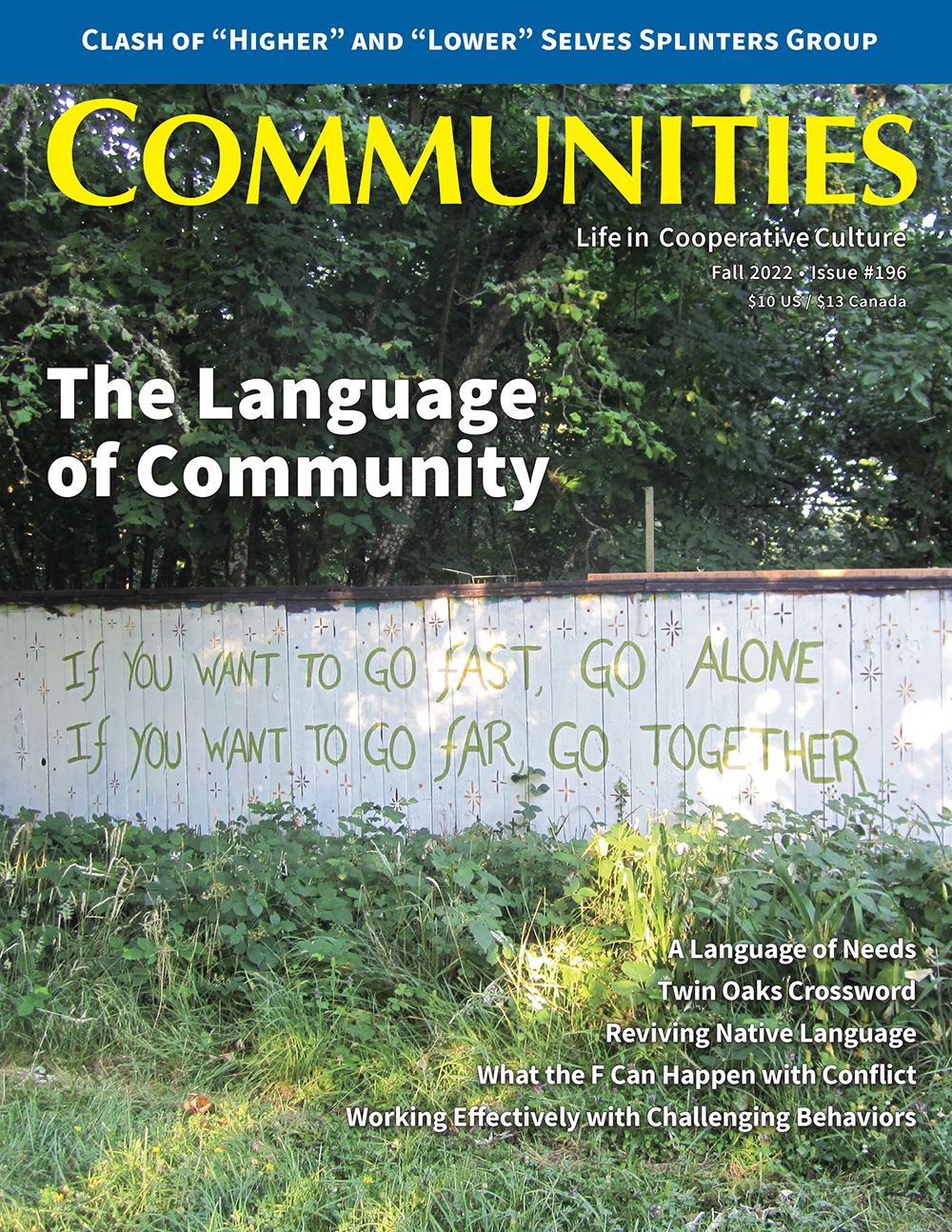
Communities #196
Fall 2022
Note: You can order a copy of this issue here.
In “The Language of Community,” articles look at compassionate communication, consensus, identity, the power of words, community dialects, aligning our words with our realities, and much more, including stories of how communities and communitarians use various kinds of language in service to cooperative culture. The issue also contains an overview of common terms describing types of intentional community, the third installment in Diana Leafe Christian’s series on “Working Effectively with Especially Challenging Behaviors,” and a larger than average dose of humor.
THE LANGUAGE OF COMMUNITY
Letter: The Vibe By Hugh Perry
The Vibe is the mortar that still binds our extended community together.
Notes in Passing: Trust and Talk By Paul Freundlich
In community, words matter less than trust. Silences and bursts of gab and action are just the externalities of a deeper flow.
A Language of Needs By Ted Rau (with Jerry Koch-Gonzalez)
The language of blame and disappointment divides us. By contrast, I see the needs language within NVC as the secret “code” that helps us understand about each other.
● Some NVC Vocabulary
The Language of Consensus By Robin Allison
Our guidelines around communication are aspirational; we don’t all get it right all the time, but we have agreed what is important to us collectively.
● Coloured Cards Decision-making Process
● Earthsong Communication Agreements
The Proper Way to “Anger”—A Marker of Belonging By Kristina Jansen
Being verbally vulnerable about emotional reactions, even violent rage, is very acceptable at Orinda as long as it’s done “the right way.”
● An Orinda Lexicon
The Language of Identity By Crystal Byrd Farmer
When we respect how someone wants to identify, we contribute to a world that values their dignity regardless of their behavior or our personal beliefs.
Language We Live By Generations of Magic Residents, adapted by Harper Hug
The languages we hear and speak, read and write, are defining qualities of our being. Changing how we use language can help us adapt to the exponentially growing challenges of our times.
garbage!, There’s a Place, remembering the Hopi Center for Human Services By Barry Peter, Water Wordsworth, and Chris Roth
My greatest teachers spoke few words, or none.
Twin Oaks Crossword By Stephan Nashoba
Folks often call us a _______, but many prefer the term “intentional community.”
A Songaia Glossary By Sylvan Bonin
When guests, interns, and friends visit, we sometimes forget that not all our common words—e.g., Biogaians, BS Committee, Second Banana, Compost Shirt—make sense to them.
“Is That Community?” By Nick Shaver
Eating cake with guilt is never as good as eating cake without the guilt. Oh how much more could we have enjoyed that treat had we known it was indeed for community!
Clash of “Higher” and “Lower” Selves Splits Community into Two By Annette Pecker
To the “uppity” ones, this exaltation of the “high” at the expense of the “low” was a reflection and result of thousands of years of patriarchal thought, belief, and action.
Changing Our Language to Reflect Our Reality By Riana Good
Refining the false binaries in our language can diminish unintentional “other-ing” and support our togetherness.
The Types of Intentional Communities: Common Terms Explained and What’s in a Name? By Cynthia Tina
It can be confusing to navigate the IC world. Here are the most common terms for types of intentional communities and what they tend to mean, as well as examples and resources for further learning.
Confederation Releases New Communities Guidebook By Water Wordsworth
Featured articles include “Finding a Community Toaster that Toasts but Doesn’t Burn” and “The Energy-Conserver’s Dilemma: What to Do when Someone Else’s Lights Are On but Nobody’s Home.”
Esperanto: The Rise, Fall, and Rise of an Intentional Language Community By Jeremy Genovese
Our conversations take place on a much more equal playing field. This is why we call Esperanto, la punta lingvo, the bridge language, a language that includes rather than excludes.
What the F Can Happen with Conflict By Laird Schaub
Over the years I’ve come to realize that the range of responses to conflict is far wider than fight or flight.
Minding the “P”s for Cues By Laird Schaub
Does this plenitude of prickly P’s provoke perturbation? Are these powerful permutations producing paroxysms of puzzlement and pique? Please put panic aside!
Working Effectively with Especially Challenging Behaviors, Part Three By Diana Leafe Christian
Boundaries are essential: we create them to protect what is important to us in our lives, to ensure that we will get what we want and need in our community, and to protect ourselves from what we don’t want.
● Narcissistic Attitudes and Behaviors
REACH
Reviving Native Language (Review: Flutes of Fire) By Chris Roth
Despite a sobering history of language suppression and near-extinction, a tremendous amount of community has grown up around preserving and reviving native California languages—and they have much to teach us.
ON THE COVER: A fence alongside Eugene, Oregon’s Riverbank Trail shares a proverb with pedestrians and cyclists. (Research suggests the saying originated in Burkina Faso, with equivalents in many languages across the African continent, and now worldwide.)
